
|
|
|
|
|
|
Classic Bikes
Custom Bikes
Individual
Racing Bikes AJP
AJS
Aprilia
Ariel
Avinton / Wakan
Bajaj
Benelli
Beta
Bimota
BMW
Brough Superior
BRP Cam-Am
BSA
Buell / EBR
Bultaco
Cagiva
Campagna
CCM
CF Moto
Combat Motors
Derbi
Deus
Ducati
Excelsior
GASGAS
Ghezzi Brian
Gilera
GIMA
Harley Davidson
Hero
Highland
Honda
Horex
Husaberg
Husqvarna
Hyosung
Indian
Jawa
Kawasaki
KTM
KYMCO
Laverda
Lazareth
Magni
Maico
Mash
Matchless
Mondial
Moto Guzzi
Moto Morini
MV Agusta
MZ / MuZ
NCR
Norton
NSU
Paton
Peugeot
Piaggio
Revival Cycles
Roland Sands
Royal Enfield
Sachs
Sherco
Sunbeam
Suzuki
SWM
SYM
Triumph
TVS
Ural
Velocette
Vespa
Victory
Vincent
VOR
Voxan
Vyrus
Walt Siegl
Walz
Wrenchmonkees
Wunderlich
XTR / Radical
Yamaha
Zero
Video
Technical
Complete Manufacturer List
|
Yamaha Tricity 300 |
| . |
|
Make Model |
Yamaha Tricity 300 |
|
Year |
2020 |
|
Engine |
4-stroke, single cylinder, SOHC, 4-valves |
|
Capacity |
292 cc / 17.8 cu-in |
|
Bore x Stroke |
70.0 x 75.9 mm |
|
Compression Ratio |
10.9:1 |
|
Cooling System |
Liquid-cooled |
|
Lubrication |
Wet sump |
|
Induction |
Fuel Injection |
|
Ignition |
TCI |
|
Starting |
Electric |
|
Max Power |
27.6 hp / 20.6 kW @ 7250 rpm |
|
Max Torque |
29.0 Nm / 21.3 lb-ft @ 5750 rpm |
|
Transmission |
V-Belt Automatic |
|
Final Drive |
|
|
Front Suspension |
Telescopic fork |
|
Front Wheel Travel |
100 mm / 3.9 in |
|
Rear Suspension |
Unit Swing |
|
Rear Wheel Travel |
84 mm / 3.3 in |
|
Front Brakes |
2x 267 mm hydraulic discs |
|
Rear Brakes |
Single 267 mm hydraulic disc |
|
Front Tyre |
2x 120/70-14M/C 55P tubeless |
|
Rear Tyre |
140/70-14M/C 62P tubeless |
|
Dimensions |
Length 2250 mm / 88.5 in |
|
Wheelbase |
1595 mm / 62.7 in |
|
Seat Height |
795 mm / 31.2 in |
|
Ground Clearance |
130 mm / 5.1 in |
|
Wet Weight |
239 kg / 527 lbs |
|
Fuel Capacity |
13 Litres / 3.4 US gal |
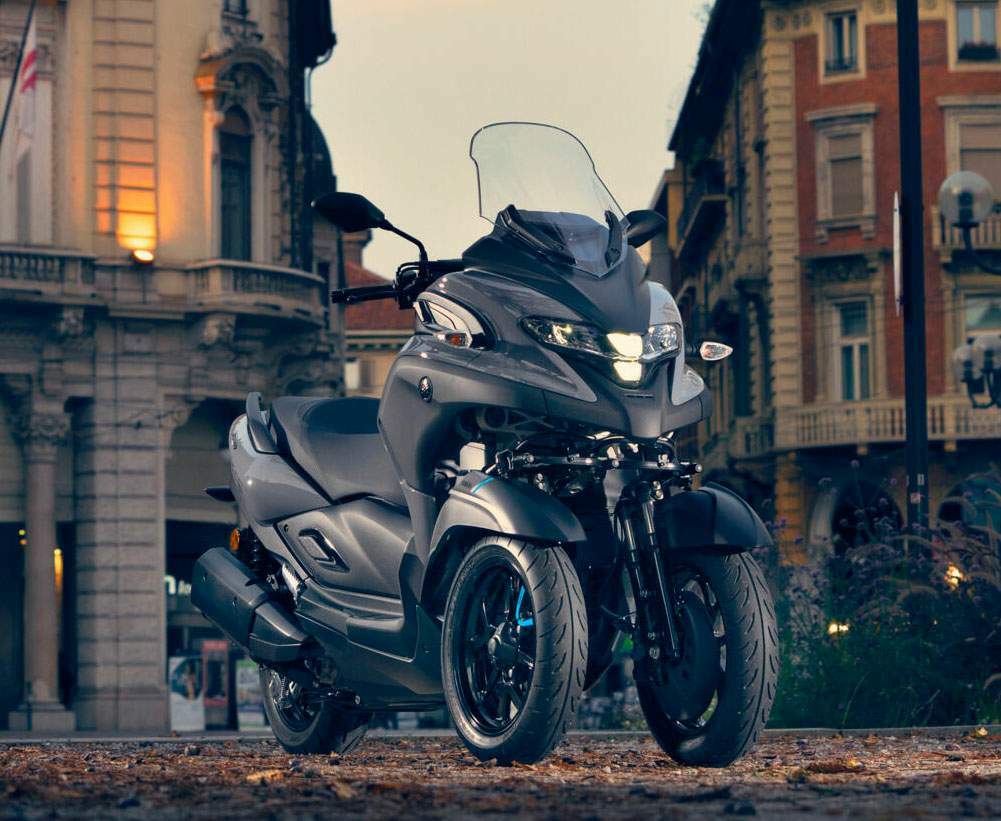
Not all 3-wheelers are the same, and the new Tricity 300 is equipped with one of the industry’s most sophisticated front-end designs. The Yamaha-exclusive Leaning Multi Wheel (LMW) technology featured on the new Tricity 300 has been proven on the Tricity 125 and then on the remarkable NIKEN Sport Tourer motorcycle, and is now adapted to meet the requirements of the Urban Mobility segment.
This highly advanced LMW Ackerman suspension/steering system features a parallelogram link and cantilevered front suspension with the dual fork tubes mounted on the inner face of the front wheels. This layout gives sporty, agile and confident handling together with enhanced feelings of stability when riding on slippery or uneven surfaces.
The advanced LMW steering mechanism also contributes towards the machine’s easy and user friendly character by giving a full 72º of steering angle, making the Tricity 300 extremely manoeuvrable in congested streets – and with a full 130 mm of ground clearance, this versatile machine is built to handle uneven surfaces and avoid being grounded out when being pushed over curbs while parking.
Having two front wheels means that the rider benefits from additional front-end traction and plenty of braking power from two front discs, and this reinforces the feelings of security, stability and confidence associated with the 3-wheel layout.
The wide 470 mm track adds to the balanced and planted character when steering and cornering, making this new urban mobility model ideally suited to new riders – and the Tricity 300’s lightweight handling will also appeal to those customers coming over to 3-wheels from a 2-wheeled scooter.
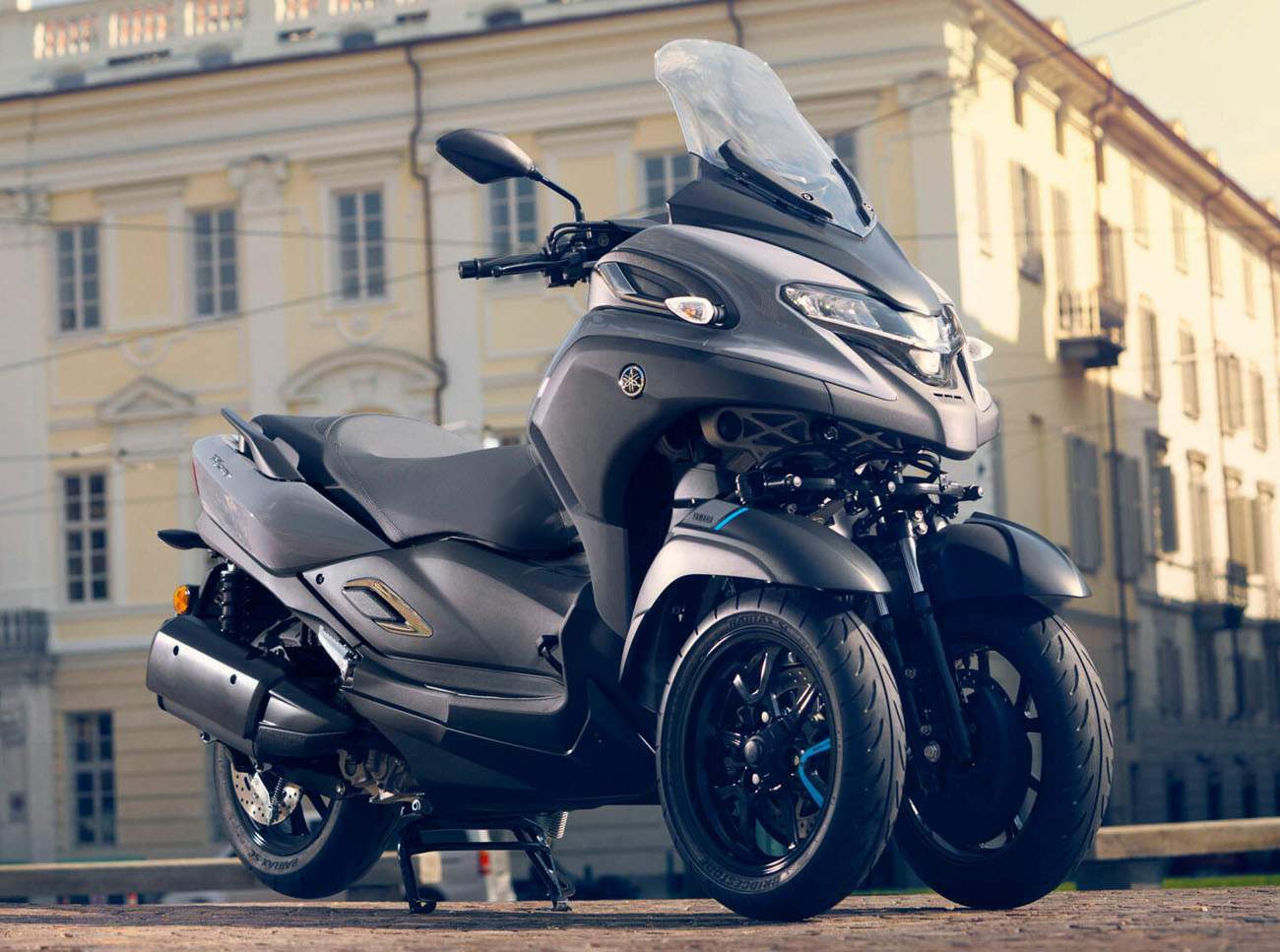
In order to achieve easy manoeuvrability together with natural steering and excellent stability, the Tricity 300 features a 1590 mm wheelbase combined with optimised steering geometry and a 470 mm track. These dimensions – combined with a front-rear weight distribution of around 50:50 with a rider on board – ensure an idealised chassis balance that contributes towards the Tricity 300’s user-friendly handling properties and lightweight feeling.
The newly designed frame is constructed with small-diameter tubing that offers a good balance of strength and rigidity – while plates are used around the head pipe area to give a precise and confident feel when steering and cornering. In order to reduce any feelings of vibration to a minimum, the engine is mounted to the new lightweight frame using a linked type system, giving a smooth and comfortable ride.
The dynamic appearance represents the further evolution of Tricity design to the next level, and also incorporates styling cues from Yamaha’s best-selling MAX Sport Scooters – as well as a touch of DNA from the NIKEN, Yamaha’s prestigious 3-wheel Sport Tourer motorcycle.
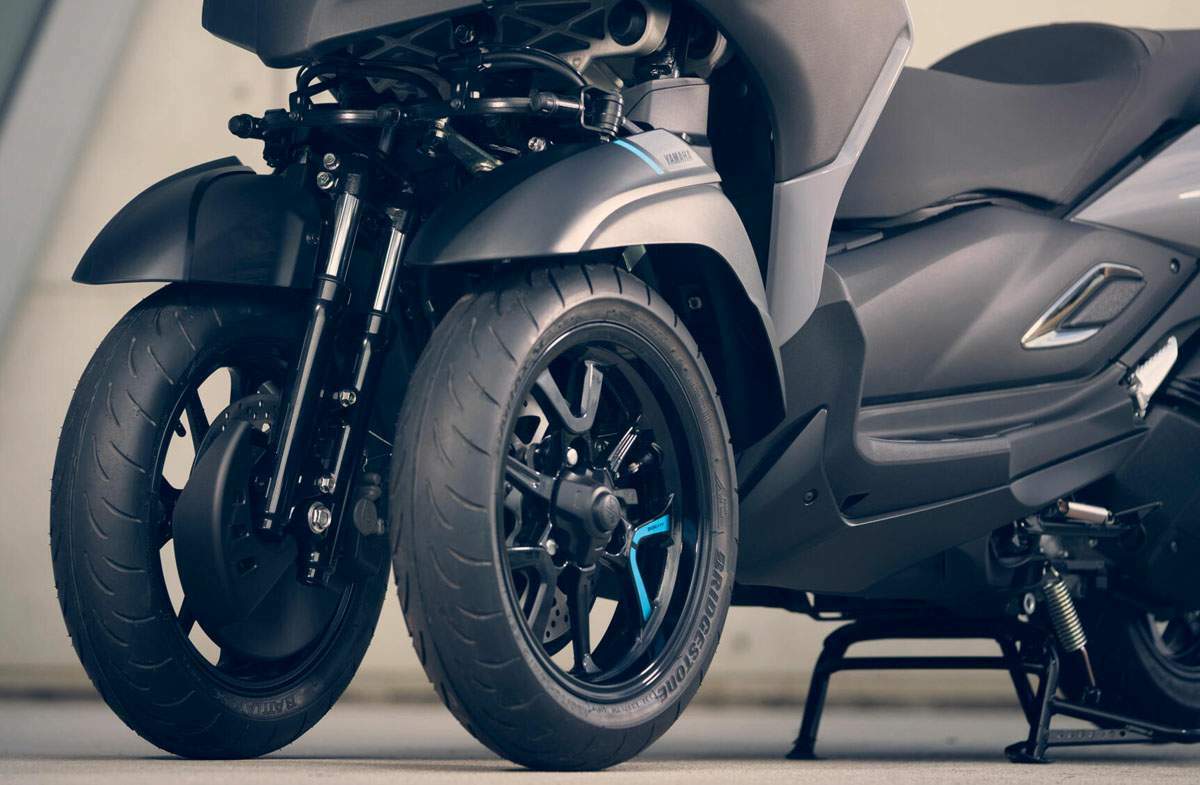
One of the most significant stylistic features on this state-of-art urban mobility vehicle is its compact and aerodynamic front cowl that is slimmer and higher than other designs in the category. With no overhang, the Tricity 300’s short and relatively narrow nose leaves an open space between the twin front wheels to emphasise the agile, light and sporty character of this model.
Viewed from the front, the finely chiselled features of the layered fairing project a cool and composed expression – and the colour co-ordinated front fenders hug the large diameter front wheels and wide 120-section tyres to convey a feeling of front-end stability and traction.
Unlike many other 3-wheelers in the 300cc+ class which feature smaller front wheels, the Tricity 300 is equipped with matching 14-inch wheels at both the front and rear, and this balanced layout conveys a planted and confident look that is in keeping with the machine’s rider-friendly character.
New 14-inch tyres have been jointly developed with Bridgestone, and while they share the same tread pattern as the Battlax scooter tyre, they feature an optimised balance of stiffness together with a new compound that have been designed to meet the specific requirements of the Tricity 300.
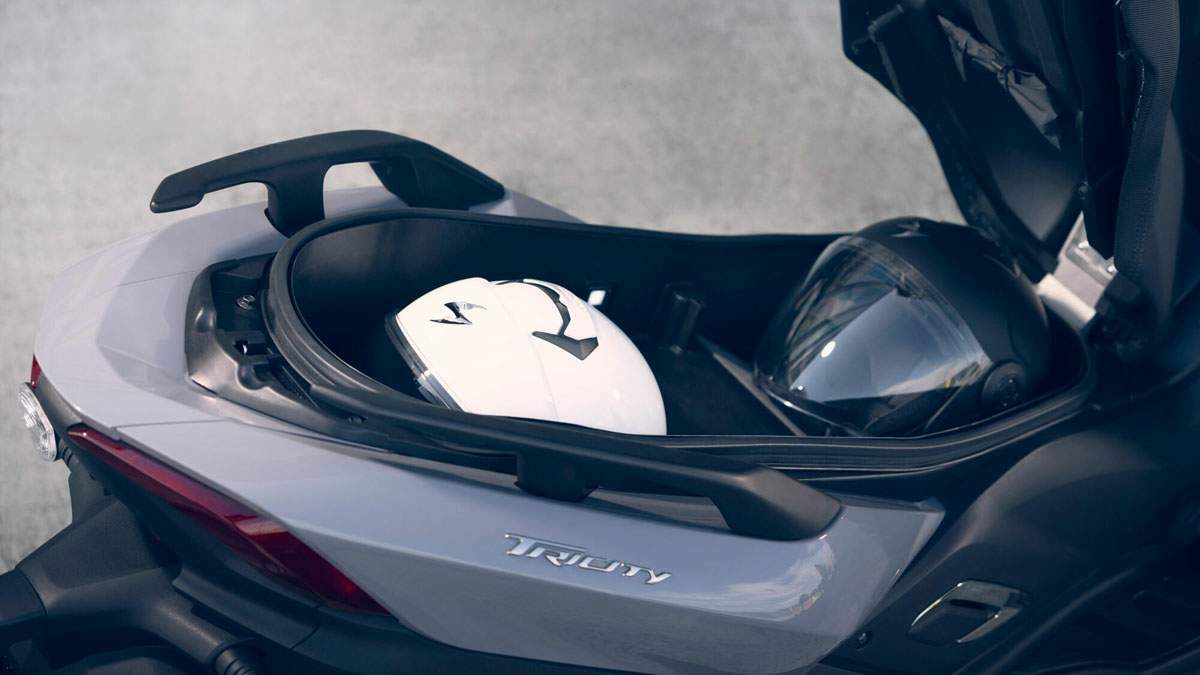
These lightweight larger diameter wheels and specially developed wide-section tyres offer a number of advantages, including high levels of traction, durability and wet weather performance, together with a smooth ride and confident roadholding.
Every feature on the Tricity 300 has been developed with the new and inexperienced rider in mind, including the best-in-class braking system. The adoption of 14-inch wheels at both the front and rear has enabled the use of large diameter 267-mm discs on all three wheels, giving greater braking controllability on a wide variety of road surfaces.
As well as being equipped with ABS to prevent accidental wheel lock ups on loose or slippery surfaces, the Tricity 300 also features Yamaha’s Unified Braking System that provides a balanced braking force to all three wheels to give enhanced control.
When the rider applies only the rear brake – either through the left handlebar lever or via the footbrake – the input passes through an equalizer that applies the braking force to the front and rear wheels. When both the front and rear brakes are applied at the same time the braking force applied to the front wheels is a combination of input from both levers; and when the front brake lever is applied on its own, only the front brakes are activated.
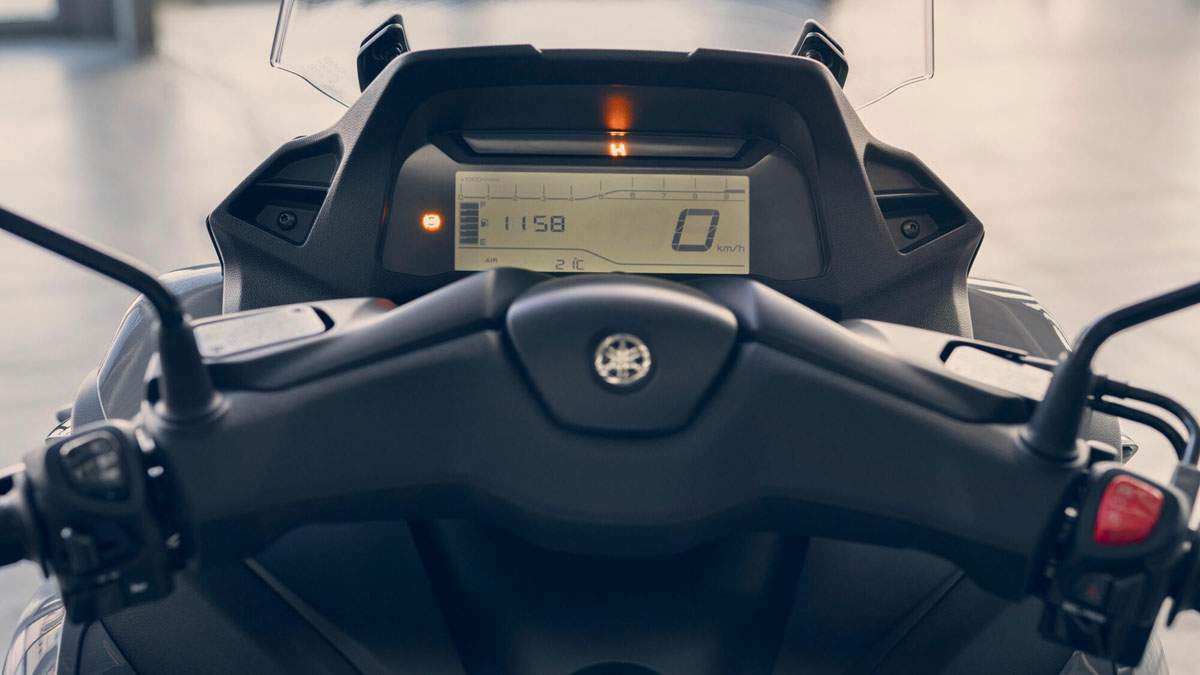
A key feature on the new Tricity 300 is its Tilt Lock Assist system that provides extra convenience by helping the machine to remain upright when stopped.
This system features a calliper and brake disc that are mounted onto the LMW mechanism’s upper parallelogram arm. When the Tilt Lock Assist system is activated, the calliper’s compact electric actuator pushes the pads onto the disc and locks the parallelogram linkage in place.
As soon as the Tricity 300 throttle is opened the Tilt Lock Assist system disengages automatically, enabling the rider to pull away smoothly and effortlessly.
The Tricity 300’s Tilt Lock Assist system is completely separated from the suspension functions, making it easier and more comfortable when pushing the Tricity 300 forwards or backwards when parking. By helping to keep the Tricity 300 temporarily in an upright position, the Tilt Lock Assist system also makes it easier when placing the vehicle on its main stand.
The new Tricity 300 is driven by Yamaha’s latest BLUE CORE engine – one of the most sophisticated designs in the category that offers an ideal balance of performance, economy and versatility. The liquid-cooled 4-stroke, SOHC, 300cc, 4-valve, single-cylinder engine is based on the advanced design used by the best-selling XMAX 300 Sport Scooter and incorporates a number of key features to suit the unique requirements of the new Tricity 300.
To achieve a high level of combustion efficiency the shape of the combustion chamber and intake port is optimised and the lightweight DiASil offset cylinder is equipped with a durable forged piston.
For strong acceleration together with good fuel efficiency and eco-friendliness, the Tricity 300 runs with revised fuel injector mapping settings, and the 12-hole injector features an optimised spray angle that increases combustion efficiency for strong low to mid-range torque.
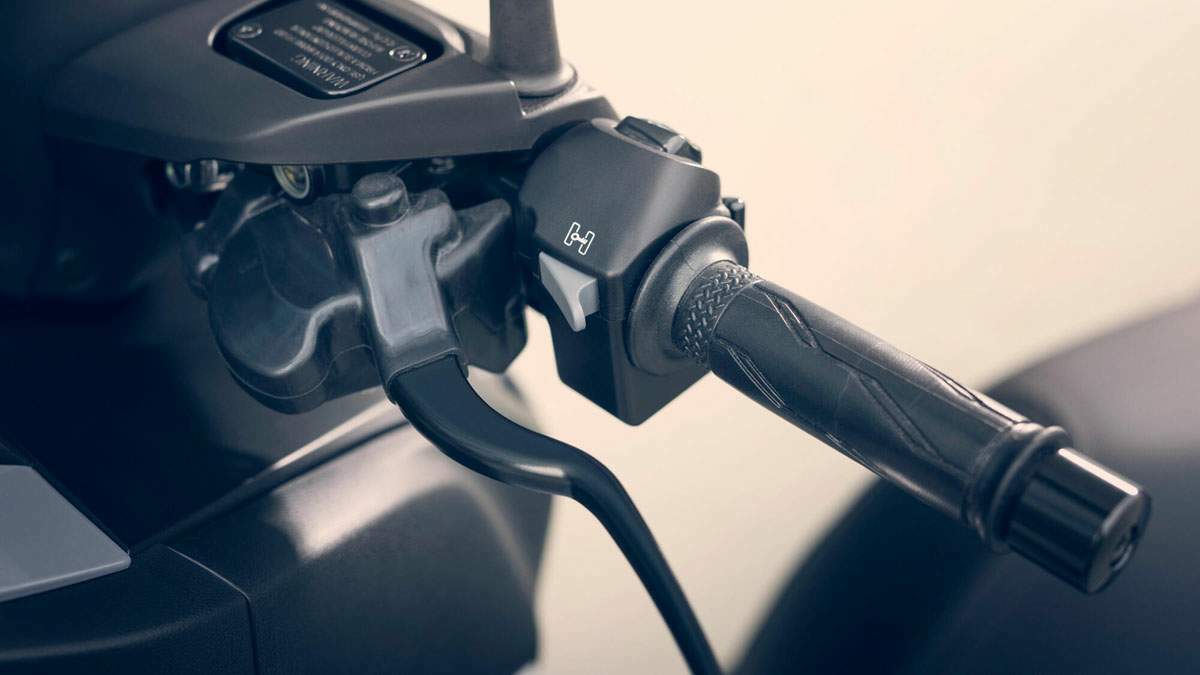
Horsepower losses are reduced by the use of a semi-dry sump lubrication system – a design also that’s also used on Yamaha’s MotoGP bikes – and the Tricity 300 is equipped with a one-piece forged crankshaft that is both lighter and more compact than conventional designs. Other notable features on this sophisticated new model include a bypass-type thermostat for the cooling system that contributes to faster engine warm-ups and greater fuel efficiency.
As well as being one of the most dynamic looking models in the 3-wheel category, the new Tricity is also one of the most practical. There’s a large storage space under the seat that can accommodate two full-face helmets or one full-face helmet and an A4-sized briefcase, and the compartment is fitted with internal LED lighting.
A parking brake secures the machine when not being ridden, while the fuel tank and seat locks can be easily released with the push of a button – and there’s also a DC outlet in the front panel for charging and powering various devices.
Using the new Tricity 300 is more convenient than ever thanks to its Smart Key system. As long as the rider has the Smart Key with them, they can carry out all of the main operations via the main switch. This includes turning the power on or off, starting and stopping the engine, and releasing the locks for the handlebars, seat and fuel tank lid.
Along with the added feelings of confidence and stability associated with the 3-wheel layout and the enhanced control offered by the ABS and Unified Braking system, the Traction Control System (TCS) adds another layer of control to the Tricity 300.
The Tricity 300’s LCD instruments are designed to provide all the relevant information in a clear and easy to understand display. There’s a large digital speedometer as well as a bar-type tachometer, clock, odometer, tripmeter and more – and along the outer edges of the panel the rider can see the indicator lights showing ABS, Tilt Lock Assist system status, TCS and ambient air temperature – with a warning light coming on at 3ºC and lower.
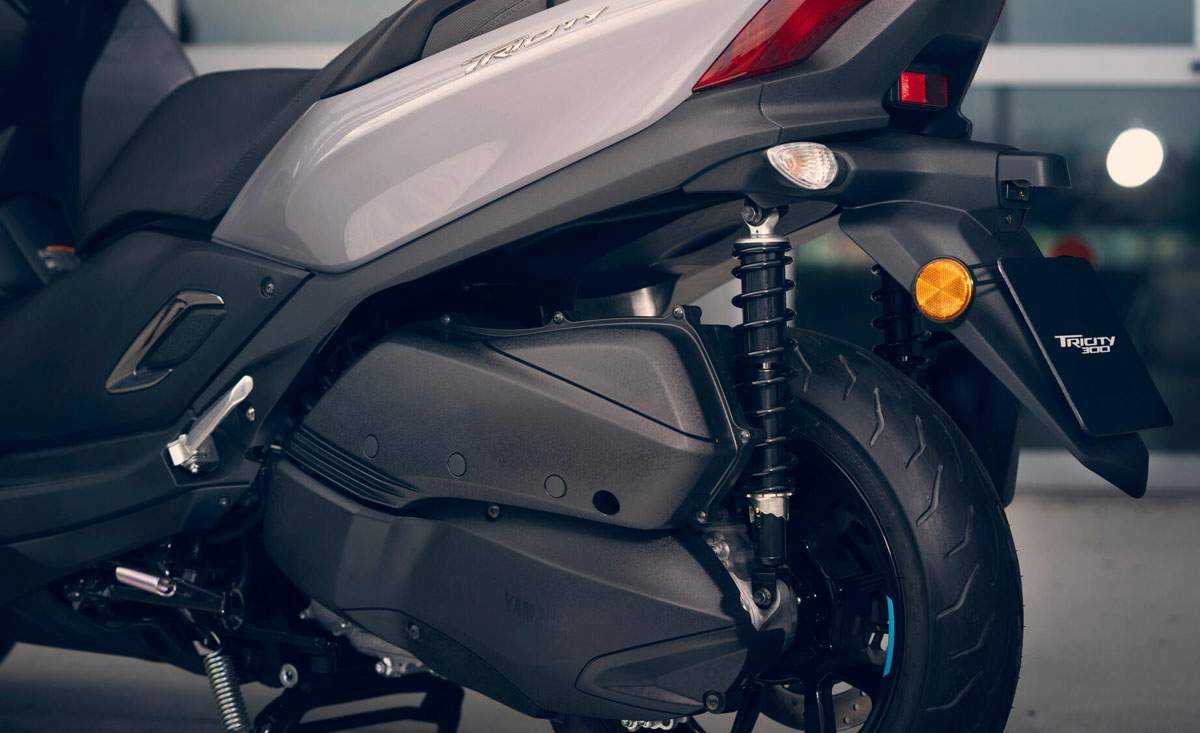
|
Any corrections or more information on these motorcycles will be kindly appreciated. |